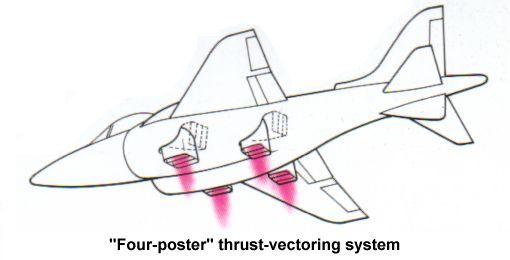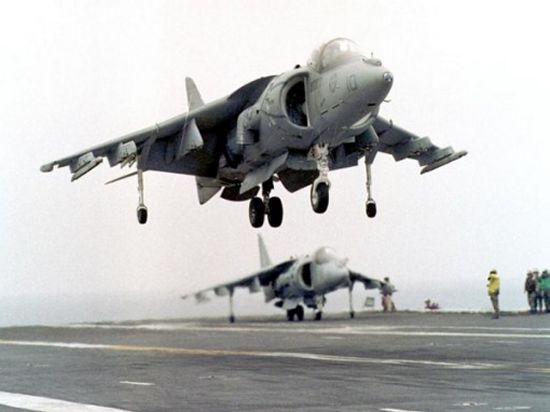|
||||||||||
|
|
||||||||||
|
||||||||||
|
|
||||||||||
Below are addressed a number of related questions we've received on the limitations of the Harrier's ability to hover.
First, we need to understand how it is that the Harrier is able to achieve hovering flight. This phenomenon we have addressed in two previous questions on Harrier thrust vectoring and its hover ability. In order to hover, a vehicle needs to produce sufficient lift force to overcome its weight. The Harrier accomplishes this task using the thrust generated by its Rolls-Royce Pegasus turbofan engine. This thrust is pointed downward using four thrust-vectoring nozzles, thereby producing a propulsive lift force that opposes the aircraft's weight.

However, the amount of thrust that an engine can produce depends on the operational conditions. For example, thrust tends to decrease with altitude since the air density decreases. In addition, hot and humid atmospheric conditions also decrease the thrust output that a jet engine can provide. These factors all play a key role in determining just how high of an altitude at which a Harrier would be able to maintain hovering flight. As a result, there may be no single value to quote for the hover ceiling of an AV-8 since it would depend so much on the thrust characteristics of the Pegasus turbofan under different operating conditions.
Unfortunately, we do not have access to any such operational data for the Harrier and can't provide any solid
numbers on its engine performance. But if we had to hazard a guess, we suspect that the Harrier can probably
maintain a static hover at altitudes up to perhaps 5,000 ft (1,525 m) or so. We will continue researching this
question in the hope of finding a more definitive answer.
- answer by Joe Yoon, 11 May 2003
We have learned that the Harrier carries a certain amount of cooling water that is needed to prevent the Pegasus
turbofan engine from overheating during hover. If operating conditions are such that the water is needed at the
maximum cooling rate, there is only enough water available to remain in hover for about 90 seconds before the
supply is exhausted. However, the aircraft rarely needs to use this cooling water at the maximum rate, and can
therefore hover for considerably longer than 90 seconds. We're just not sure how long "considerably longer" is.
We've observed the Harrier hovering at airshows for periods of time on the order of 5 minutes or more. Based on
these numbers, our best guess is that the maximum time limit over which the Harrier can maintain hover is probably
around 10 minutes or so. We will continue our research into this issue to locate a more conclusive answer.
- answer by Greg Alexander, 11 May 2003

But the idea that a vehicle needs to push against the ground in order to hover is really misleading. Distance from the ground does play a role, but purely due to the decrease in atmospheric density as altitude increases and its impact on the thrust characteristics of a jet engine. For this reason, I think your statement that the Harrier "could hover at any height, within the limitations of the jet itself" is correct. The view that "pushing against the ground" is the limiting factor is at best overly simplistic and fails to capture the fundamental physics of how the Harrier achieves hovering flight.
And your observations about the Harrier's ability to perform "pop-up" style missions are correct. The Harrier does
not have the ability to perform in this manner owing to the short duration of its maximum hover
time. In addition, the Harrier is quite a noisy aircraft, particularly when in hover, and also kicks up a
great deal of dust and debris when its thrust is deflected downward. These traits would obviously be a great
detriment when attempting to hide behind trees and would easily give away the vehicle's position. Nevertheless,
the Harrier is a popular aircraft for use in close air support primarily because it can operate from unprepared
landing strips near the front lines. This capability gives the Harrier faster reaction times once air support is
requested and a higher sortie rate than aircraft located at some far off air base or aircraft carrier.
- answer by Greg Alexander, 11 May 2003
Related Topics:
Read More Articles:


|
Aircraft | Design | Ask Us | Shop | Search |

|
|
| About Us | Contact Us | Copyright © 1997- | |||
|
|
|||